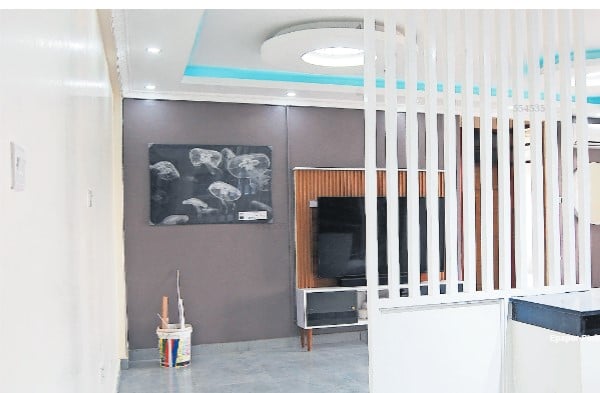Prime
Martin Senkubuge: Finding the colourful side of vitiligo

What you need to know:
- The different shade. It started with an artwork Senkubuge did to address the rampant issue of skin bleaching. While explaining his work, he mentioned Michael Jackson as a famous bleaching case. Unknown to him, he was wrong about the icon and the audience knew it. Researching the Jackson case gave him a new cause, writes Bamuturaki Musinguzi.
Visual artist and researcher, Martin Quid Senkubuge says he was prompted to dedicate part of his art career to the cause of the people living with the vitiligo skin condition when a potential fine art buyer declined to buy his painting due to his ignorance and failure to differentiate between the melanin and vitiligo skin conditions nearly two years ago.
Senkubuge recalls the encounter at a collective art exhibition, Walls Speak on September 28, 2019 in Kampala, where he had also displayed his artwork.
“A lady from the crowd wanted to buy my painting, Melanin tattoo which was addressing challenges associated with bleaching. She was ready to pay Ushs1.3 million ($363), but, first, she wanted to know the story behind thepainting.”
In his narration, he claimed that late American icon Michael Jackson had bleached to turn himself white.
“She immediately got detached from the artwork because she was aware of the legend’s vitiligo skin condition.”
She said, “I thought artists make research before they present their work!”
Learning about vitiligo
From that moment, Senkubuge, says, he decided to find out more about Jackson’s vitiligo story.
“I discovered that Jackson had received a lot of criticism from many of his followers, who thought that he wanted to change his colour. With teary eyes, in his interview with Oprah Winfrey on February 10, 1993, Jackson explained his vitiligo skin condition. He sounded falsely judged, stigmatised and I wondered if a public figure like him could feel like that, how about a less privileged vitiligo person in my remote village where society tells him or her that he or she is a curse or a bad omen and many more forms of speculation and myths associated with vitiligo.”
In September 2019, he founded the Part of Us Initiative, a visual campaign of creating awareness about the vitiligo skin condition and other humanitarian causes in Uganda, Africa, and the rest of the world. The main objective of the initiative is to visually amplify and raise vitiligo voices, fight against stereotypes and stigma, and embrace vitiligo as a natural and normal skin condition.
“Through an online survey in April and May 2020, respondents revealed that many vitiligo people in Uganda, East Africa and relatedly Africa and beyond have lived with stigma, trauma, emotional stress and social injustice, among others,” says the youthful artist.
He reveals that almost everyone has stayed silent about the plight vitiligo people are in. As a visual artist who has lived different kinds of life, he decided to be the visual voice of the vitiligo fraternity.
“While efforts are in place to recognise and act on minor neglected diseases and disorders worldwide, vitiligo has not significantly attracted attention. In Uganda, there’s no specific health programme addressing the plight of persons with vitiligo. A wide range of traditions and myths about vitiligo have continued to inflict trauma, stigma, emotional and psychological stress on the People Living with Vitiligo (PLWV),” Senkubuge says.
The grant
In 2019, his Vitiligo art project won a small project grant worth Ushs2 million ($559) from Goethe Zentrum Kampala (GZK) after his concept was considered as unique and brilliant. Since 2020, he has been running a campaign of inclusiveness of the pride of people living with vitiligo in Uganda. He is working with vitiligo communities and the Vitiligo Association of Uganda (VAU).
Senkubuge’s inaugural vitiligo art exhibition, Part of Us was held at the Goethe Zentrum Kampala from April 7 to 30, 2021. It was a showcase of his Vitiligo Art Project.
In his powerful charcoal portraiture drawings of persons with vitiligo around Kampala, he explored the beauty, uniqueness, sense of inclusiveness, sense of belonging and pride of people living with vitiligo. A public discussion on the skin condition held on April 7 attracted the media, skin experts, public and the vitiligo patients.
The portraiture drawings of vitiligo patients on display were of Isaac Kyoyeta, Eva Atukunda and Davis Tushabomwe, who volunteered to be part of the first edition of this project meant to end the stigma and change lives, of many others around Uganda and the whole world. The exhibition will be held every after two years.
The art
Senkubuge is a hyperrealism artist, some of his works are identical to the photography that inspires them.
“The Vitiligo Art Project started under the theme Part of Us and this drawing project portrays vitiligo beauty and I am so grateful to bring smiles to the vitiligo people’s faces on top of sensitising masses about vitiligo through my art,” Senkubuge says.

Part of us. Senkubuge poses with one of his models at the exhibition. Photo / Courtesy.
According to Senkubuge, the project went through the three phases of research, photo-shooting and drawing, and the exhibition. He drew each artwork for averagely 35 days (8 hours per day). He completed the drawings in five months and three weeks.
“When Martin explained to me that the project was to create awareness about vitiligo, I just knew I had to be part of it,” Atukunda says.
While Kyoyeta, says: “I decided to be part since I am in the show business this was a great opportunity of exploring more and gain more self-confidence about living with a different skin type, and assure others that vitiligo is not a disability.”
Senkubuge says he is conveying his message through portraiture drawings.
“I chose to use portraiture in order to capture facial expressions, character, personality, identity of the vitiligo persons and this enabled the viewers to connect with the project. I chose faces and upper limbs (portraiture) because vitiligo mostly starts from these parts that are exposed to the sun.”
As to how he managed to convince Kyoyeta, Atukunda and Tushabomwe to be part of this project. Senkubuge, says, “After reaching out to over 60 vitiligo contacts around Kampala during the early days of the first lockdown last year, it was challenging to explain myself and intentions through phone calls. Movements were restricted so I could not meet these people for physical conversations. I shared my vision about vitiligo with many but Eva, Isaac and Davis are the ones who trusted me.”
“Isaac in particular is a passionate and outstanding model and vixen who liked the idea of photo-shoot and incredible hand drawing of him. Eva is passionate about representing and transforming vitiligo lives. She clearly understood my visual representation of her in my hyperrealism drawings. Davis is my close friend right from primary school and he always wants to see me giving back to community through my talent. They all asked me to do as I had promised which I have done, and I am glad that the vitiligo community now trusts me.”
Living with the condition
On how he has been living with the vitiligo skin condition, Kyoyeta says, “I am living positively and loving myself more after embracing the new colour on my skin though there are challenges especially with the people around me. Most of the times, I am isolated treated as an outcast and being treated as vulnerable. But I am very happy that I encourage other people with vitiligo to move with their heads high. I am grateful for who I am.”
While Atukunda says, “Vitiligo is a painless skin condition so it’s easy to live with it once you accept the condition. My family has been so supportive since I got it and that has made it much easier.”
As to the main changes that people with this condition face in Uganda, Atukunda, says stigma from both people around and self-inflicted problems, “Vitiligo can cause one to lose their self-esteem, and if one doesn’t get people to talk to, they can be affected mentally.”
The available treatments are expensive and because vitiligo isn’t curable, it means continued spending for different medical trials.
“Most people can’t afford the genuine sunscreens,” Atukunda adds.
“Not all people with vitiligo are comfortable enough to move around exposed and so use makeup to cover up the affected areas - which makeup is quite expensive,” Atukunda says.
Medics say
On the magnitude of this condition in Uganda, Dr. Faizo Ssekindi, a dermatologist in Kampala, says, Uganda’s estimated incidence is 0.5-1.2 per cent. It occurs at any age with the peak onset of 10-25 years (50 per cent develops before the age of 20 years).
Is there a known form of treatment?
According to Dr. Ssekindi, most vitiligo types have no cure, however, early detection and diagnosis is very important.
“Commonly steroids are prescribed in Uganda and they are effective in some types. Examples of topical steroids prescribed include hydrocortisone, betamethasone and mometasone. Injectable ACTH is the common systemic steroid prescribed.”
According to Senkubuge, the art project has been well received by public. Many have confessed through media comments of how they got to know about vitiligo for the first time through this project. “I encourage everyone to have a receptive heart and also be ready to end all sorts of stereotypes, speculations and myths associated with vitiligo,” he says.
Benefits
According to Senkubuge, after his April exhibition he agreed with a team of over 20 volunteers to partner with different humanitarian organisations, art galleries or any individual wiling to host this impactful Part of Us exhibition in accessible spaces like conference rooms, main halls, hotel meeting rooms and any available space, so that they can reach out to bigger audiences as they create awareness about vitiligo.
“256 Arts TV offered to make a documentary about this project and we already did all the coverage waiting for the editors to complete it. This documentary shall be used to reach out to many people online in these times of the pandemic Covid-19,” Senkubuge said.
Senkubuge says artists have a role in championing causes such as creating awareness about the vitiligo because they have a high sense of imagination which they can use to either build or destroy the world through our executions.
“One of my philosophies as a researcher and a visual artist; is that the more we paint, draw and showcase a challenge based on research, we can positively influence transformations in various societal perceptions.”
Following the success of his Part of Us exhibition, Senkubuge was selected among the eight aspiring curators by Nommo Gallery (National Gallery), Makerere Art Gallery, and Uganda National Cultural Centre, to be a part of the Collective Memories Curatorial training workshop sponsored by Newcastle University in the UK. The workshop aims at re-institutionalization of Ugandan art.
In brief
Senkubuge was born in 1996, in Isingiro District in Western Uganda. He went St. Aloysius Primary School Nyamitanga in Mbarara District. He attended Ntare School in Mbarara for his O and A-level. He holds a BSc of Industrial and Fine Arts (First Class) from Makerere University in Kampala.
Senkubuge’s artworks are inspired by his background together with life experiences since childhood. He has participated in various art related conferences, art forums, talk shows as well as exhibitions since 2017.
Asked to describe Senkubuge as an artist, Atukunda observed: “Martin is a very friendly, charismatic and very talented fellow. We struck a friendship so quickly which made it easy for me to work with him. Unlike many artists that do art just for the money, Martin’s art aims to create a positive impact on people.”
While Kyoyeta said: “Ssekubuge is a self-driven artist who can create something unique out of the impossibilities, loves helping one achieve their dreams like me personally and his gentle and polite.”
Senkubuge was the biggest seller at the “Walls Speak” art exhibition held on September 28, 2019, at the Kingdom Kampala building, organized by Rotary Club and Wonder Art Gallery. His painting titled “Global Warming” was auctioned at $4,000 by Ntinda Metropolitan Rotarians, and these funds were used to facilitate health services in one of the hospitals in Eastern Uganda.
He also featured in the Fashion Summit 2019; Abraynz Styles and Fashion Awards, (ASFAS19) as a guest visual artist. He also made it to the Short list of the Top 5 in the Mukumbya Musoke Art Prize 2020, a biannual art prize in Uganda.
WHAT IS VITILIGO?
According to the Vitiligo Society based in London (UK), vitiligo, also called ‘leucoderma’ is a long-term skin condition that causes an area of the skin to lose its colour (pigmentation), which results in the area looking white or pink in appearance.
Vitiligo can actually appear anywhere on the body, but it’s more likely to develop in some of the following areas: eyes, nostrils, belly button, elbows, and genital areas; occasionally found inside of the mouth; areas of the body that have folds, such as the knees and elbows. Because pigment cells give colour to hair as well as skin, some people with vitiligo may notice early onset greying of the hair or a loss of colour on the lips.
According to the Vitiligo Society, there is no prejudice in terms of who can develop the condition. Therefore, it can affect anyone, whatever their skin colour or ethnic origin, but will be more visually prominent in those with darker skin. People with fairer skin colour may not even realise that their skin is not making pigment.
According to the Vitiligo Research Foundation (VRF) based in New York, USA, the good news is that vitiligo – upsetting as it can be to those living with it – is neither life threatening nor contagious.




